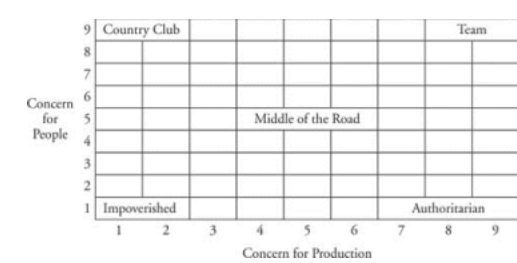
A. Upward Communication
1) The grievance procedure: The grievance procedure allows employees to make an appeal upward beyond their immediate supervisor. It protects individuals from arbitrary action by their direct supervisor, and encourages communications concerning complaints.
2) Open door policy: This, in literal sense, means the superiors’ door is always open to subordinates. It is a continuous invitation for subordinates to come in and talk about anything that is troubling them. Unfortunately, in practice, the open door policy is more of fiction than fact.
3) Counselling, attitude questionnaires, and exit interviews: The personnel department can greatly facilitate subordinate-initiated communication by conducting non directive, confidential counselling sessions, periodically administering attitude questionnaires, and holding meaningful exit interviews for those who leave the organization. Much valuable information can be gained from these forms of communication.
4) Participating techniques: These may be accomplished by either informal involvement of subordinates or formal participation programs such as use of junior boards, union management committees, and suggestion boxes. Empirical research evidence indicates that participants in communication networks are generally more satisfied with their jobs, are more committed to their organization, and are better performers than those who are not involved in the communication process.
5) Ombudsperson: A largely untried but potentially significant technique to enable management to obtain more subordinate-initiated communication is the use of the ombudsperson. The concept has been used primarily in Scandinavia to provide an outlet for persons who have been treated unfairly or in a depersonalized manner by a large, bureaucratic government. Although it is just being introduced in a few business organizations, if set up and handled properly, it may work where open door policy has failed. As business organizations become larger and more depersonalized, the ombudsperson may fill an important void that exists under these conditions.
B. Other Forms of Communication
These include communication that runs downwards, laterally, and diagonally.
1) Use of appropriate language: Words, gestures, and symbols should be appropriate to receiver’s level of understanding.
2) Practice emphatic communication: The receiver’s frame of reference (i.e. assumptions and attitudes) should be understood by the communicator.
3) Encourage feedback: Two-way communication can improve the communication process. Through feedback, a communicator can check whether a message has been accurately received.
4) Develop a climate of trust: Communication is enhanced if participants have a trusting relationship. Gaining and maintaining the trust of others requires continual effort and the willingness to engage in honest and frank dialogue.
5) Use of appropriate media: The form of communication should match the situation. Oral communication is best for discussing employee problems such as tardiness and poor performance. Written communication is best in matters that require future action but is slow for issues that call for quick action, and too impersonal for discussing employee problems. A combination of oral followed by written communication is best for conveying information that requires quick action, job-specific directions, and procedural changes.
6) Encourage effective listening: Techniques that encourage more effective listening are the avoidance of evaluative judgements, listening to the total meaning of the sender’s message and offering responsive feedback (sometimes called active listening) about the listener’s degree of understanding.
Titany answered the question on September 20, 2021 at 13:00
- Discuss three Forms of organizational communication(Solved)
Discuss three Forms of organizational communication
Date posted: September 20, 2021. Answers (1)
- Describe the Reinforcement theory of motivation(Solved)
Describe the Reinforcement theory of motivation
Date posted: September 20, 2021. Answers (1)
- Describe the David McClelland’s learned needs Theory of motivation(Solved)
Describe the David McClelland’s learned needs Theory of motivation
Date posted: September 20, 2021. Answers (1)
- Describe the Alderfer’s ERG Theory of motivation(Solved)
Describe the Aldermen's ERG Theory of motivation
Date posted: September 20, 2021. Answers (1)
- Limitations of the Hierarchy of Needs Model (Solved)
Limitations of the Hierarchy of Needs Model
Date posted: September 20, 2021. Answers (1)
- List three characteristics of learning organizations(Solved)
List three characteristics of learning organizations
Date posted: September 20, 2021. Answers (1)
- Describe three situational leadership theories(Solved)
Describe three situational leadership theories
Date posted: September 20, 2021. Answers (1)
- Forms of power used by managers to change employee behaviour (Solved)
Forms of power used by managers to change employee behaviour
Date posted: September 20, 2021. Answers (1)
- Identify the leadership styles found in the managerial grid model below
(Solved)
Identify the leadership styles found in the managerial grid model below

Date posted: September 20, 2021. Answers (1)
- Abilities that successful leaders possess according to Peter Drucker(Solved)
Abilities that successful leaders possess according to Peter Drucker
Date posted: September 20, 2021. Answers (1)
- Identify six core characteristics that the majority of effective leaders possess(Solved)
Identify six core characteristics that the majority of effective leaders possess
Date posted: September 20, 2021. Answers (1)
- Describe the importance of leadership in an organisation(Solved)
Describe the importance of leadership in an organisation
Date posted: September 20, 2021. Answers (1)
- Define directing in relation to leadership(Solved)
Define directing in relation to leadership
Date posted: September 20, 2021. Answers (1)
- Describe the employee compensation(Solved)
Describe the employee compensation
Date posted: September 20, 2021. Answers (1)
- Limitations of performance appraisal (Solved)
Limitations of performance appraisal
Date posted: September 20, 2021. Answers (1)
- List three components of performance appraisal(Solved)
List three components of performance appraisal
Date posted: September 20, 2021. Answers (1)
- Purpose of evaluating the employees(Solved)
Purpose of evaluating the employees
Date posted: September 20, 2021. Answers (1)
- Types of training in an organization(Solved)
Types of training in an organization
Date posted: September 20, 2021. Answers (1)
- Describe the ways that employers use to identify a suitable individual for a vacant post(Solved)
Describe the ways that employers use to identify a suitable individual for a vacant post
Date posted: September 20, 2021. Answers (1)
- List three external recruiting strategies in an organization(Solved)
List three external recruiting strategies in an organization
Date posted: September 20, 2021. Answers (1)